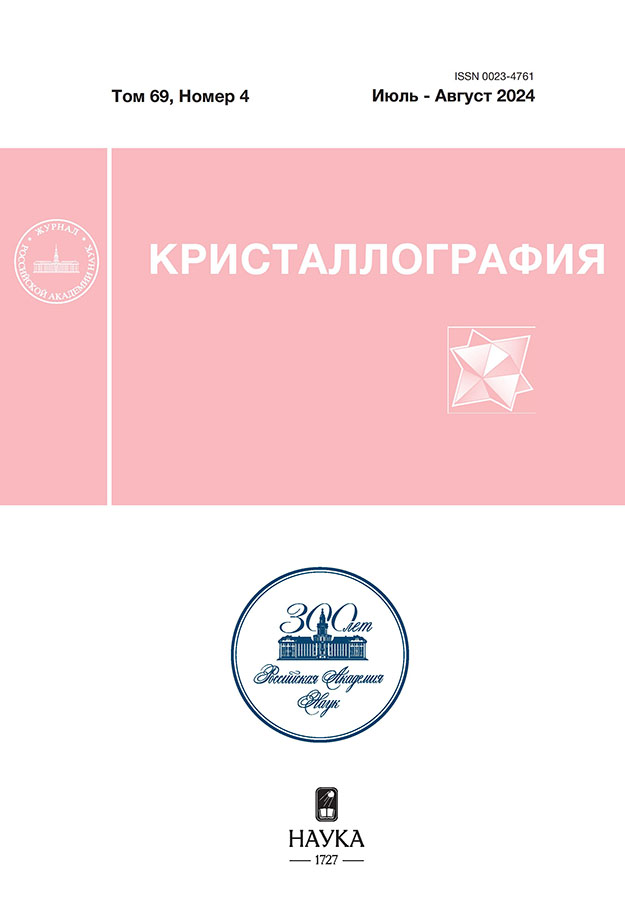Temperature influence on the stability of the precursor cluster of the thermolysin crystal
- Авторлар: Kordonskaya Y.V.1, Timofeev V.I.2, Marchenkova M.А.2,3, Pisarevsky Y.V.2, Silvestrova S.Y.4, Dyakova Y.A.1, Kovalchuk M.V.1,2
-
Мекемелер:
- National Research Centre “Kurchatov Institute”
- NRC “Kurchatov Institute”
- Southern Federal University
- The Loginov Moscow Clinical Scientific Center Moscow Health Department
- Шығарылым: Том 69, № 4 (2024)
- Беттер: 694-699
- Бөлім: CRYSTAL GROWTH
- URL: https://permmedjournal.ru/0023-4761/article/view/673159
- DOI: https://doi.org/10.31857/S0023476124040165
- EDN: https://elibrary.ru/XBSOKY
- ID: 673159
Дәйексөз келтіру
Аннотация
We used the molecular dynamics method to assess the stability of the precursor-cluster (hexamer) of thermolysin crystal over a wide range of temperatures (10–90°C). The simulation results showed that as the temperature increases, the stability of the hexamer, in general, decreases, however, the hexamer does not dissociate at any of the considered temperatures. At a temperature of 60°C, an increase in the stability of the hexamer was observed. This value is close to the temperature of maximum enzymatic activity of thermolysin (70°C). Based on the analysis of the results, it was assumed that the crystallization of thermolysin could be carried out at 60°C.
Толық мәтін
Авторлар туралы
Y. Kordonskaya
National Research Centre “Kurchatov Institute”
Хат алмасуға жауапты Автор.
Email: yukord@mail.ru
Ресей, Moscow
V. Timofeev
NRC “Kurchatov Institute”
Email: yukord@mail.ru
Shubnikov Institute of Crystallography of Kurchatov Complex of Crystallography and Photonics
Ресей, MoscowM. Marchenkova
NRC “Kurchatov Institute”; Southern Federal University
Email: yukord@mail.ru
Shubnikov Institute of Crystallography of Kurchatov Complex of Crystallography and Photonics; The Smart Materials Research Institute
Ресей, Moscow; Rostov-on-DonY. Pisarevsky
NRC “Kurchatov Institute”
Email: yukord@mail.ru
Shubnikov Institute of Crystallography of Kurchatov Complex of Crystallography and Photonics
Ресей, MoscowS. Silvestrova
The Loginov Moscow Clinical Scientific Center Moscow Health Department
Email: yukord@mail.ru
Ресей, Moscow
Y. Dyakova
National Research Centre “Kurchatov Institute”
Email: yukord@mail.ru
Ресей, Moscow
M. Kovalchuk
National Research Centre “Kurchatov Institute”; NRC “Kurchatov Institute”
Email: yukord@mail.ru
Shubnikov Institute of Crystallography of Kurchatov Complex of Crystallography and Photonics
Ресей, Moscow; MoscowӘдебиет тізімі
- Marchenkova M.A., Boikova A.S., Ilina K.B. et al. // Acta Naturae. 2023. V. 15. № 1. P. 58. https://doi.org/10.32607/ACTANATURAE.11815
- Du S., Wankowicz S.A., Yabukarski F. et al. // bioRxiv. 2023. https://doi.org/10.1101/2023.05.05.539620
- Kordonskaya Y.V., Timofeev V.I., Dyakova Y.A. et al. // Crystals. 2022. V. 12. № 11. P. 1645. https://doi.org/10.3390/CRYST12111645
- Kovalchuk M.V., Boikova A.S., Dyakova Y.A. et al. // J. Biomol. Struct. Dyn. 2019. V. 37. № 12. P. 3058. https://doi.org/10.1080/07391102.2018.1507839
- Kordonskaya Y.V., Timofeev V.I., Dyakova Y.A. et al. // Mend. Commun. 2023. V. 33. № 2. P. 225. https://doi.org/10.1016/J.MENCOM.2023.02.024
- van den Burg B., Eijsink V. // Handbook of Proteolytic Enzymes. 2013. V. 1. P. 540. https://doi.org/10.1016/B978-0-12-382219-2.00111-3
- Lam M.P.Y., Lau E., Liu X. et al. // Comprehensive Sampling and Sample Preparation: Analytical Techniques for Scientists. 2012. P. 307. https://doi.org/10.1016/B978-0-12-381373-2.00085-5
- Adekoya O.A., Sylte I. // Chem. Biol. Drug. Des. 2009. V. 73. № 1. P. 7. https://doi.org/10.1111/J.1747-0285.2008.00757.X
- DeLano W.L. // The PyMOL Molecular Graphics System, Version 1.8; Schrödinger, LLC: New York, NY, USA, 2015.
- Jurrus E., Engel D., Star K. et al. // Protein Sci. 2018. V. 27. № 1. P. 112. https://doi.org/10.1002/PRO.3280
- Van Der Spoel D., Lindahl E., Hess B. et al. // J. Comput. Chem. 2005. V. 26. № 16. P. 1701. https://doi.org/10.1002/jcc.20291
- Lindorff-Larsen K., Piana S., Palmo K. et al. // Proteins: Structure, Function and Bioinformatics. 2010. V. 78. № 8. P. 1950. https://doi.org/10.1002/prot.22711
- Horn H.W., Swope W.C., Pitera J.W. et al. // J. Chem. Phys. 2004. V. 120. № 20. P. 9665. https://doi.org/10.1063/1.1683075
- Dimitropoulos D., Ionides J., Henrick K. // Curr. Protoc. Bioinf. 2006. P. 14.3.1–14.3.3.
- Michaud-Agrawal N., Denning E.J., Woolf T.B., Beckstein O. // J. Comput. Chem. 2011. V. 32. № 10. P. 2319. https://doi.org/10.1002/JCC.21787
- Gowers R.J., Linke M., Barnoud J. et al. // 15th Python in Science Conference, Los Alamos, NM (United States), Sep 11. 2016. P. 98. https://doi.org/10.25080/Majora629e541a-00e
- Sousa Da Silva A.W., Vranken W.F. // BMC Res Notes. 2012. V. 5. № 1. P. 1. https://doi.org/10.1186/1756-0500-5-367/FIGURES/3
- Essmann U., Perera L., Berkowitz M.L. et al. // J. Chem. Phys. 1995. V. 103. P. 8577. https://doi.org/10.1063/1.470117
- Berendsen H.J.C., Postma J.P.M., Van Gunsteren W.F. et al. // J. Chem. Phys. 1984. V. 81. № 8. P. 3684. https://doi.org/10.1063/1.448118
- Parrinello M., Rahman A. // J. Chem. Phys. 1982. V. 76. № 5. P. 2662. https://doi.org/10.1063/1.443248
- Van Gunsteren W.F., Berendsen H.J.C. // Mol. Simul. 1988. V. 1. № 3. P. 173. https://doi.org/10.1080/08927028808080941
- Hess B., Bekker H., Berendsen H.J.C., Fraaije J.G.E.M. // J. Comput Chem. 1997. V. 18. P. 1463. https://doi.org/10.1002/(SICI)1096-987X(199709)18:12<1463:: AID-JCC4>3.0.CO;2-H
Қосымша файлдар













